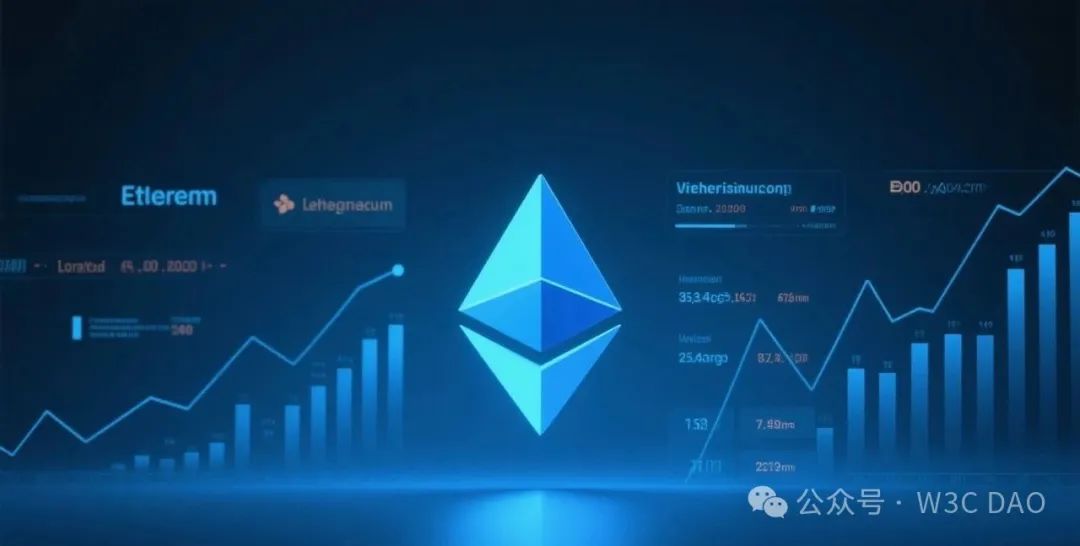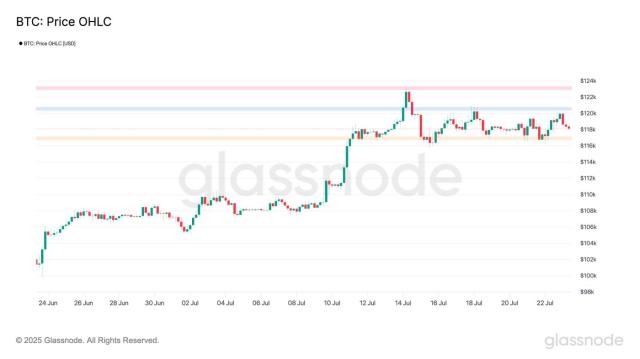Source: W3C DAO
Author: Mask
Original Title: Bitcoin's Story is Unfolding on Ethereum
After Michael Saylor's Bitcoin reserve strategy was emulated by over 50 companies, Wall Street has turned its attention to more productive assets, and this time, Ethereum has become the protagonist.
"We are experiencing an Ethereum treasury arms race," said dForce founder Yang Min in a recent commentary, "with old OG vehicles like Sharplink and Wall Street vehicles like Bitmine, with many more on the way."

Bitcoin's story is being replayed on Ethereum.
Wall Street capital is quietly reaching for Ethereum. As traditional financial giants like BlackRock and Fidelity enter through spot ETFs, a race for ETH reserves led by listed companies has quietly begun - in just two months, over 50 institutions have accumulated more than 1.6 million ETH, valued at over $5 billion.
These new capital players are no longer satisfied with passive holding, but are delving into the core of crypto economics through staking and yield farming. In just a few months, publicly traded companies have sparked a wave of incorporating Ethereum into their balance sheets - from gambling technology companies on the brink of delisting to Bitcoin miners, from Silicon Valley leaders to Ethereum co-founders, corporate treasuries are becoming the capital pillars of the Ethereum ecosystem, with a capital race around Ethereum reserves unfolding.
I. Four Pioneers: Full Map of Listed Companies' ETH Reserves
Since mid-2025, four US listed companies have become typical representatives of incorporating Ethereum into their balance sheet strategies, revealing the internal logic of this trend.
1. SharpLink Gaming (SBET): Largest Institutional ETH Holder
This gambling technology company, which had been losing money for years, saw its stock price surge 650% in a single day after announcing a strategic transformation in May, with a cumulative three-day increase of 17.56 times. Through a combination of PIPE and ATM, SharpLink has accumulated over 280,000 ETH (approximately 205,634), surpassing the Ethereum Foundation to become the world's largest ETH institutional holder. Its core strategy is to stake 95% of ETH reserves, earning 322 ETH in just one month, directly participating in network security while obtaining stable cash flow.
2. BitMine Immersion (BMNR): Wall Street Approach Replicator
Backed by "Wall Street oracle" Tom Lee (Fundstrat co-founder), BitMine raised $250 million through private placement, adding 81,380 ETH, with total holdings exceeding 163,000 ETH, becoming the second-largest ETH reserve listed company. Its distinctive feature is maintaining Bitcoin mining business while replicating MicroStrategy's reserve logic, using ETH as a strategic balance sheet supplement, at the cost of 13-fold equity dilution. PayPal co-founder Peter Thiel holds 9.1% of the company's shares through his entity, highlighting Silicon Valley capital's recognition of this trend.

3. Bit Digital (BTBT): Clearing Out Bitcoin to Invest in Ethereum
As a former Bitcoin mining company, Bit Digital made an aggressive transformation in June 2025: selling 280 BTC and raising $172 million through equity financing, increasing ETH reserves to 100,603. Its past staking annual yield reached 3.2%, with CEO Sam Tabar emphasizing this move as an active bet on ETH's income-generating ability.
4. GameSquare (GAME): Targeting DeFi to Enhance Yields
This game media group, in collaboration with crypto institution Dialectic, launched an ETH reserve plan targeting $100 million. Its unique approach is using the Medici platform to invest ETH in lending and liquidity provision DeFi protocols, pursuing 8%-14% annual yields, significantly higher than basic staking returns. The first $5 million ETH purchase has been completed, marking the traditional gaming industry's active move towards crypto economics.
II. Capital Logic Behind Stock Price Surges: Common Traits of ETH Reserve Companies
These companies announcing ETH reserve strategies have shown remarkable stock performance. BitMine's stock price surged 3000% in a month, from $4.50 to $111.50; BTCS's stock price jumped 110% on the day of announcing its ETH reserve plan; SharpLink and Bit Digital's stock prices also saw significant increases of 30% and 20% respectively.
Behind the market reaction are key shared traits: these companies were generally facing financial difficulties before transformation. SharpLink's 2024 revenue was only $3.66 million, a year-on-year drop of 26%; BitMine had a net loss of $3.29 million in 2024; Bit Digital's first-quarter 2025 loss reached $44.5 million.
They all chose to build ETH reserves entirely through equity financing, avoiding leverage and convertible debt, significantly reducing systemic risk - in stark contrast to many Bitcoin reserve companies' leverage-dependent models.
Wall Street has given significant premiums to ETH reserve companies. GameSquare's market value premium relative to its ETH reserve book value is as high as 13.8 times; BitMine's premium is about 5 times after its latest financing; Bit Digital and SharpLink have more moderate premiums. These high premiums reflect the market's optimistic expectations about these companies' strategic prospects.
III. Ethereum's Value Leap: From Storage Asset to Productive Capital
The core driving force of corporate capital flowing into Ethereum lies in its unique productive characteristics. Unlike Bitcoin's passive, gold-like value storage positioning, Ethereum provides the ability to create active income through staking and DeFi strategies. Different from Bitcoin reserves' "digital gold" logic, listed companies' ETH allocation highlights three-dimensional progressive value:

1. Staking Creates Cash Flow: Cases of SharpLink and BitDigital prove that ETH staking can provide 3%-5% annual yields, transforming idle reserves into productive assets. This solves the pain point of Bitcoin reserves' inability to generate cash flow.
Currently, over 32 million ETH are staked, with annual yields between 3%-5%. According to Ethereum's technical roadmap, validator economic optimization will raise staking annual yields to 6-8%, with staking thresholds gradually lowering from 32 ETH to 16 ETH or even 1 ETH.
This will drive the ETH staking rate from the current 25% to over 40%, locking about 48 million ETH and further reducing circulating supply.
2. DeFi Yield Engine: GameSquare's target yield of 8%-14% reveals a more aggressive capital utilization path. By providing liquidity and re-staking, enterprises can participate in Ethereum ecosystem value distribution, forming a growth flywheel of "stablecoin trading growth → increased Gas fees → rising ETH demand → increased staking → enhanced network security".
Enterprises can enhance yields through diversified strategies. SharpLink chooses basic staking; GameSquare pursues 8%-14% enhanced yields through DeFi strategies; Bit Digital combines staking and on-chain activities for comprehensive returns. This flexibility is Ethereum's unique advantage as a corporate reserve asset.
3. Ecosystem Stability Anchor: When enterprises stake ETH, they essentially become network validator node supporters. Statistics show that in early July, Ethereum's staking volume exceeded 35 million, accounting for over 30% of total volume. The influx of corporate reserves significantly enhances the network's attack resistance. Capital and protocol health form a symbiotic relationship.
Ethereum's technological evolution has strengthened its fundamental support. In the next two years, five key technological directions include: zkEVM integration will reduce zero-knowledge proof verification costs by 80%; RISC-V new architecture will lower Gas costs by 50-70%; L1-L2 collaborative approach will reduce cross-layer transaction costs by 90%; and the return of sharding technology.
These upgrades will significantly enhance network performance and generate entirely new application scenarios such as high-frequency trading and AI inference. "Institutions choose Ethereum because it is stable, secure, and does not go offline." - Vitalik Buterin recently emphasized!
IV. Market Impact and Future Outlook, Capital and Technology Synergistic Evolution
Enterprise ETH reserves are already showing market impact, with the ETH/BTC exchange rate rising over 50% in the past four months. Analysts predict it may continue to rise 30%, reaching 0.035 BTC. Ethereum ETF has seen consecutive 12 weeks of capital inflow, totaling $990 million, which is 19.5% of its managed assets, far higher than Bitcoin ETF's 9.8%.

As listed companies' ETH holdings surge, traditional capital is quietly reconstructing its influence on the Ethereum ecosystem:
1. Holding Scale Reshuffling: Institutional holdings exceed 1.6 million ETH, accounting for 35% of spot ETF total scale. Newcomers like SharpLink and BitMine have surpassed holdings of the Ethereum Foundation (242,500 ETH) and traditional whales like Golem.
2. Governance Rights Concerns: Current entrants are mostly financially driven institutions aiming to "hedge inflation, boost stock prices, or seek short-term gains". If they continue expanding holdings, the governance discourse of developer communities and early OG investors might be diluted.
3. Spiritual Leader Absence: While Bitcoin has Michael Saylor as a spiritual leader, Ethereum has yet to find a spokesperson with both faith appeal and capital influence. Whether Wall Street figures like Tom Lee can fill this gap remains uncertain.
dForce founder Yang Mindao predicts that listed companies' Ethereum holdings might reach 10% of total circulating supply (close to the 30% staking proportion), which will be "the biggest structural change in Ethereum's capital and governance structure."
This structural transformation will deeply bind corporate interests with Ethereum network health, forming a symbiotic relationship.
However, challenges remain. High premiums might amplify downside risks during ETH price corrections; while DeFi strategies offer higher yields, they also come with additional risks; regulatory uncertainty remains the Damocles sword hanging over all crypto assets.

Standard Chartered Bank predicts ETH price might reach $14,000 by the end of 2025, with independent analyst Sassano seeing it even higher at $15,000. Driven by price expectations, more listed companies might join the ETH reserve ranks. The three-tier yield system of basic staking (3%-5%) → DeFi portfolio strategies (8%-14%) → re-staking derivative yields is gradually maturing, allowing enterprises to customize reserve plans based on risk appetite.
When traditional corporate treasuries form a positive capital loop with blockchain protocols, this might be the most solid anchor of the crypto economy. SharpLink's stock price myth and BitMine's capital surge reveal Ethereum's transformation from a developer's paradise to an enterprise-level financial infrastructure.
Institutional capital's entry is not the endpoint, but the starting point of Ethereum's value network deeply integrating with real-world economics. When ETH in listed companies' treasuries continuously "generates blood" through staking and DeFi, when corporate earnings are deeply bound with network security - this reserve competition that began with financial returns will ultimately reshape the symbiotic logic of capital and technology.
The ultimate proposition of blockchain might be to make value flow as unstoppably as code. When corporate treasuries and blockchain protocols form a positive capital loop, this might be the most solid anchor of the crypto economy.






